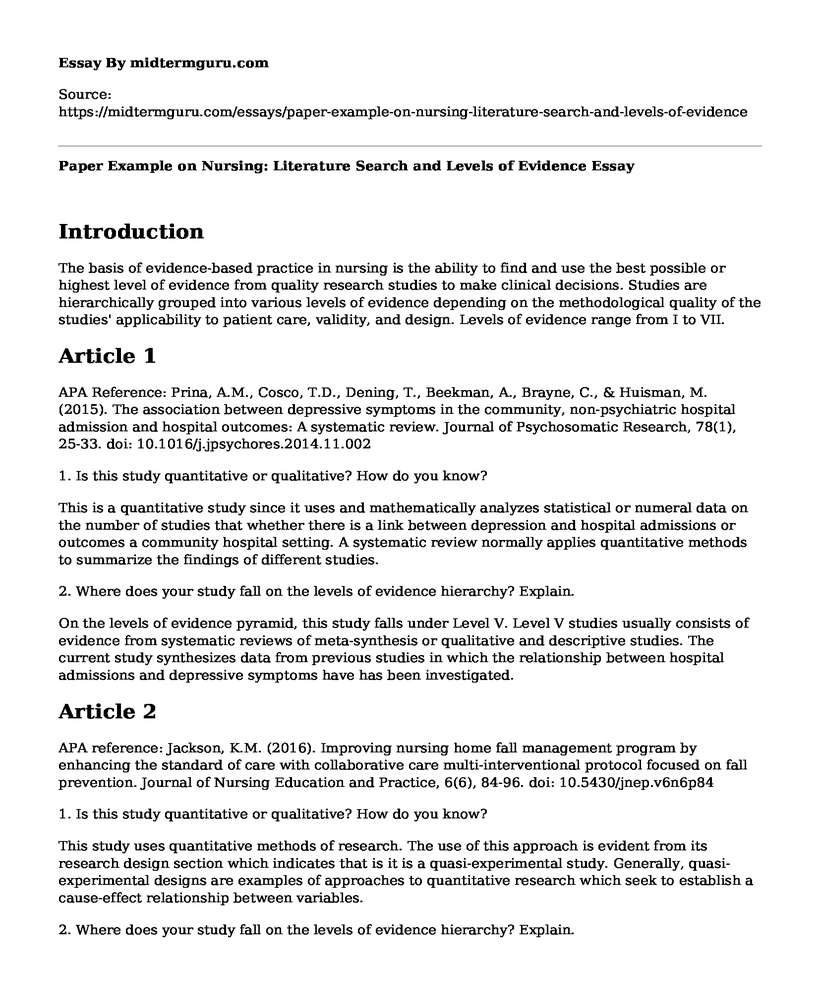Introduction
The basis of evidence-based practice in nursing is the ability to find and use the best possible or highest level of evidence from quality research studies to make clinical decisions. Studies are hierarchically grouped into various levels of evidence depending on the methodological quality of the studies' applicability to patient care, validity, and design. Levels of evidence range from I to VII.
Article 1
APA Reference: Prina, A.M., Cosco, T.D., Dening, T., Beekman, A., Brayne, C., & Huisman, M. (2015). The association between depressive symptoms in the community, non-psychiatric hospital admission and hospital outcomes: A systematic review. Journal of Psychosomatic Research, 78(1), 25-33. doi: 10.1016/j.jpsychores.2014.11.002
1. Is this study quantitative or qualitative? How do you know?
This is a quantitative study since it uses and mathematically analyzes statistical or numeral data on the number of studies that whether there is a link between depression and hospital admissions or outcomes a community hospital setting. A systematic review normally applies quantitative methods to summarize the findings of different studies.
2. Where does your study fall on the levels of evidence hierarchy? Explain.
On the levels of evidence pyramid, this study falls under Level V. Level V studies usually consists of evidence from systematic reviews of meta-synthesis or qualitative and descriptive studies. The current study synthesizes data from previous studies in which the relationship between hospital admissions and depressive symptoms have has been investigated.
Article 2
APA reference: Jackson, K.M. (2016). Improving nursing home fall management program by enhancing the standard of care with collaborative care multi-interventional protocol focused on fall prevention. Journal of Nursing Education and Practice, 6(6), 84-96. doi: 10.5430/jnep.v6n6p84
1. Is this study quantitative or qualitative? How do you know?
This study uses quantitative methods of research. The use of this approach is evident from its research design section which indicates that is it is a quasi-experimental study. Generally, quasi-experimental designs are examples of approaches to quantitative research which seek to establish a cause-effect relationship between variables.
2. Where does your study fall on the levels of evidence hierarchy? Explain.
The studies fall on Level VIII of the evidence hierarchy. Often, level VIII consists of evidence acquired from quasi-experimental studies with well-deisgned controlled trials that lack randomization. This study uses a longitudinal quasi-experimental design in assessing the effectiveness of a collaborative multi-strategy fall risk management program in reducing patient falls in a nursing facility.
Conclusion
In conclusion, the level of evidence hierarchy provides a concise classification of evidence from research studies based on the strength and quality of their designs and validity, hence helping inform nursing practice and decision making. The learning point from this paper is that while conducting research on any practicum issue in nursing or healthcare in general, one has to first determine which level in the evidence pyramid it belongs as this will determine its applicability to a healthcare setting.
Cite this page
Paper Example on Nursing: Literature Search and Levels of Evidence. (2022, Sep 15). Retrieved from https://midtermguru.com/essays/paper-example-on-nursing-literature-search-and-levels-of-evidence
If you are the original author of this essay and no longer wish to have it published on the midtermguru.com website, please click below to request its removal:
- Nursing Understaffing Research Article
- Whether Human Immunodeficiency Infection Causes Aids - Paper Example
- Role and Purpose of Clinical Supervision - Paper Example
- Essay on Phenomenon of the Physician-Assisted Suicide
- Causes and Effects of Cancer: Annotated Bibliography
- Euthanasia: A Delicate Way to End Suffering and Pain - Research Paper
- Why People Fear Visiting the Dentist: Reasons and Solutions - Essay Sample







